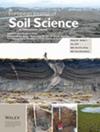实验室测量不确定度的效用:以开放土壤光谱库服务为例
摘要
土壤光谱学为传统的湿化学方法分析土壤特性提供了快速和经济的替代方案,具有广泛的适用性,适用于不同的土壤类型和地理区域。这一前景导致了大型光谱库和在线建模工具的创建,包括开放土壤光谱库(OSSL)。虽然这些工具可以推进土壤光谱学,但它们通常依赖于实验室参考测量无误差的假设。在这项研究中,我们评估了OSSL引擎从中红外光谱预测27种土壤性质的准确性,明确地考虑了实验室测量的不确定性。预测的性质包括碳组分(总、有机、无机)、总氮、阳离子交换容量、电导率、1:1 pH、1:2 CaCl2 pH、粒度组分(粘土、淤泥、砂)、nh4oac可提取的K、Ca、Mg和Na;KCl-extractable基地;Mehlich III可萃取K、Ca、Mg、Na、Al、Mn、Fe、Cu和B;以及布雷和奥尔森两种方法提取的磷。光谱预测的质量是通过北美能力测试(NAPT)项目的分析结果来评估的,NAPT是一个地理上多样化的数据集,包括来自多个实验室的标准化土壤测量数据。为了量化预测性能,将OSSL预测值与NAPT中位数值进行比较,使用几种常见的统计指标,包括Nash-Sutcliffe效率系数(NSE)、一致性相关系数(CCC)、性能与四分位数范围之比(RPIQ)和标准化偏差。当与中值测量相比较时,碳和粒度分数以及CEC预测得很好。总氮、1:1和1:2 pH、Mehlich III可萃取的Ca、Al和Mg,以及NH4OAc可交换的Mg均有较好的预测。所有其他土壤性质都没有得到很好的预测。为了进一步评估在实验室测量不确定度背景下OSSL预测的可靠性,我们评估了落在预定义公差范围内的预测值的比例。具体来说,我们计算了预测值落在中位数绝对偏差(MAD)与中位数NAPT值的2.5到4倍之间的百分比。这些阈值与NAPT程序用于识别潜在错误的实验室测量的阈值一致,并作为可接受的不确定度界限的代理。超过80%的OSSL预测在napt可接受的CEC、无机C和粘土的测量范围内。粉砂、总碳和有机碳、砂和全氮的预测在50%以上的时间内都在可接受的范围内。在可接受的测量范围内预测的所有其他土壤性质不到50%。这些结果表明OSSL预测可以取代农业表层土壤的CEC测量。这些结果强调了在评估OSSL预测时包括实验室测量不确定性的重要性。我们鼓励在评估所有土壤光谱模型的质量时纳入不确定性估计。



Soil spectroscopy offers the promise of rapid and cost-effective alternatives to traditional wet chemistry methods for analyzing soil properties, with broad applicability across soil types and geographic regions. This promise has led to the creation of large spectral libraries and online modeling tools, including the Open Soil Spectral Library (OSSL). While these tools can advance soil spectroscopy, they often rely on the assumption that laboratory reference measurements are error-free. In this study, we evaluated the accuracy of the OSSL engine in predicting 27 soil properties from mid-infrared spectra, explicitly accounting for uncertainty in laboratory measurements. Predicted properties included carbon fractions (total, organic, inorganic), total nitrogen, cation exchange capacity, electrical conductivity, 1:1 pH, 1:2 CaCl2 pH, particle-size fractions (clay, silt, sand), NH4OAc-extractable K, Ca, Mg, and Na; KCl-extractable Al; Mehlich III extractable K, Ca, Mg, Na, Al, Mn, Fe, Cu, and B; and phosphorus extracted by both Bray and Olsen methods. The quality of spectral predictions was evaluated using analytical results from the North American Proficiency Testing (NAPT) program—a geographically diverse dataset comprising standardized soil measurements from multiple laboratories. To quantify predictive performance, OSSL predictions were compared to the median NAPT values using several common statistical metrics, including the Nash–Sutcliffe efficiency coefficient (NSE), concordance correlation coefficient (CCC), ratio of performance to interquartile range (RPIQ), and standardized bias. When compared against median measurements, the carbon and particle size fractions and CEC were predicted well. Total N, 1:1 and 1:2 pH, Mehlich III extractable Ca, Al, and Mg, and NH4OAc exchangeable Mg were moderately well predicted. All other soil properties were not well predicted. To further evaluate the reliability of OSSL predictions in the context of laboratory measurement uncertainty, we assessed the proportion of predicted values falling within predefined tolerance ranges. Specifically, we calculated the percentage of predictions that fell within 2.5 and 4 times the median absolute deviation (MAD) from the median NAPT value. These thresholds are consistent with those used by the NAPT program to identify potentially erroneous laboratory measurements and serve as a proxy for acceptable uncertainty bounds. More than 80% of OSSL predictions were within NAPT-acceptable measurement ranges for CEC, inorganic C, and clay. Silt, total and organic carbon, sand, and total N predictions were within the acceptable ranges more than 50% of the time. Less than 50% of all other soil properties were predicted within acceptable measurement ranges. These results suggest that OSSL predictions could replace CEC measurements for agricultural surface soils. These results highlight the importance of including the uncertainty of laboratory measurements when evaluating OSSL predictions. We encourage the inclusion of uncertainty estimates when evaluating the quality of all soil spectral models.

 求助内容:
求助内容: 应助结果提醒方式:
应助结果提醒方式:


